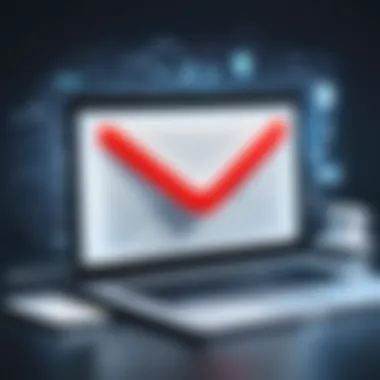In-Depth Insights into Google Email Protection Services


Intro
Email security has become a critical aspect of both business operations and personal communication. Google, a leading player in the tech industry, offers robust email protection mechanisms designed to combat growing threats. Understanding the intricacies of these protections is essential for individuals and organizations alike. This piece will provide a thorough exploration of Google email protection strategies, including their technical frameworks, various security protocols employed, and the specific benefits these features offer.
The relevance of email protection cannot be overstated. With the rise of cyber threats such as phishing, malware, and spam, having an effective security posture is vital. Google’s solutions not only provide immediate protection but also foster a safer digital environment for online communications.
Software Needs Assessment
Identifying User Requirements
Before implementing any email protection solution, it is crucial to assess the specific needs of the users. Understanding the type of information being communicated and the potential threats is a starting point. For businesses, this may involve identifying the volume of sensitive data, the number of employees, and their technical capabilities. Users often require a friendly interface, coupled with advanced options to customize security levels.
Evaluating Current Software Solutions
Once user requirements are established, evaluating existing software solutions becomes necessary. Google provides several features such as Gmail’s Spam filter, phishing detection, and built-in encryption. Each of these tools must align with the identified requirements to determine their effectiveness in combating threats.
- Gmail's Spam Filter: Automatically filters potential spam based on known characteristics.
- Phishing Detection: Uses machine learning to identify and warn users about suspicious emails.
- End-to-End Encryption: Protects email content during transmission, ensuring privacy.
By assessing current solutions, users can discern whether Google’s offerings meet their needs or if additional tools are required to enhance their security landscape.
Data-Driven Insights
Market Trends Overview
The email security market is evolving. Increasing reliance on digital communication necessitates advanced protection services. Many organizations are shifting to cloud-based solutions, reflecting a broader trend towards scalability and ease of access.
Key trends include:
- Integration of Artificial Intelligence for real-time threat detection.
- Increased adoption of zero-trust models that emphasize user identity verification.
- Greater emphasis on compliance with regulations such as GDPR.
Performance Metrics
The performance of email protection systems can be quantified through various metrics. Metrics such as false positive rates, detection time, and user feedback provide insight into a solution's effectiveness.
Important Note: Regular evaluations of these performance metrics are crucial to ensure the security measures in place continue to meet evolving threats.
By grounding decisions in data-driven insights, businesses can tailor their email protection strategies more effectively, ensuring they remain resilient against potential threats.
Prolusion to Google Email Protection
In a world where digital communication has become a vital aspect of both personal and professional life, the security of email systems cannot be understated. The necessity for robust email protection grows as threats evolve in complexity and frequency. Google Email Protection plays a pivotal role in safeguarding information, ensuring that users can communicate securely without falling prey to cyber threats. This section provides insights into the importance of having a structured approach to email security, focusing on how Google's solutions address specific vulnerabilities.
Understanding the Need for Email Security
Email remains a primary vector for cyber attacks, making it essential for organizations and individuals to prioritize security measures. Common threats include phishing, malware, and ransomware, which exploit unsuspecting users. Effective email security not only protects sensitive data but also fosters trust in digital communications. Google Email Protection offers comprehensive solutions that address these needs, using advanced technologies to filter spam and detect malicious content. Understanding the need for email security helps forge a proactive approach to mitigating risks, enabling users to engage confidently in online communications.
A Brief History of Google Email Services
Google's journey in the email services landscape started with the launch of Gmail in 2004. Initially marked by limited storage and innovative features, Gmail rapidly gained popularity. Over the years, Google expanded its email offerings, introducing features like spam filtering, two-factor authentication, and robust cybersecurity measures. This evolution reflects a growing awareness of the cyber threats users face. Today's Google Email Protection integrates advanced machine learning algorithms, bolstering its defenses against ever-shifting threats. The historical context enriches the understanding of how Google has adapted its services to better protect users in the digital age.
Overview of Google’s Approach to Email Protection
In today’s digital environment, the security of email communication is essential. Google has developed a multifaceted approach to email protection, which not only focuses on safeguarding users but also enhances the overall integrity of communication. The significance of this approach is evident, as it reflects an understanding of diverse email threats and emphasizes proactive measures. Google’s strategy combines a variety of security layers to shield users from spam, phishing attempts, and potential malware attacks.
The primary goal of Google’s email protection framework is to ensure that users can communicate without the constant fear of compromise. Businesses and individual users alike benefit from this robust system, as it aims to reduce incidents of data breaches and unauthorized access. The approach also involves continuous updates and improvements, based on the latest cyber threat intelligence.


Core Components of Email Protection
Google's email protection consists of several key components working in harmony to form an effective line of defense. These elements are designed to identify and neutralize various threats before they reach users’ inboxes. Some core components include:
- Spam Filtering: Advanced algorithms sift through incoming emails to classify them. This helps in identifying spam or irrelevant content, ensuring that legitimate messages remain accessible.
- Phishing Detection: Google employs sophisticated methods to recognize phishing attempts. These methods analyze the sender's reputation along with link safety to help users avoid potential traps.
- Malware Scanning: Emails are scanned for malicious attachments and links that could compromise security. If threats are detected, protective actions are automatically taken to prevent infections.
- Encryption: Protection extends beyond threat detection to include encryption protocols. This ensures that emails sent within the platform are secure and confidential, protecting sensitive information.
Understanding these components is critical for users looking to enhance their own email safety strategies. They are foundational elements that underpin Google’s commitment to secure communications.
Integration with Google Workspace
Google’s approach to email protection is also closely tied with Google Workspace, which enhances the functionality and security of the entire suite. This integration ensures seamless protection across various applications, from Gmail to Google Drive.
- Unified Security Features: Users benefit from consistent security protocols across multiple platforms, which allows for a more comprehensive security experience.
- Collaboration Tools Protection: As more businesses rely on collaborative tools, Google has ensured that data shared within these applications is constantly monitored and protected.
- User Management Controls: Admins in Google Workspace have the ability to set policies tailored to their organization’s needs. This includes configuring settings for email protection, ensuring a higher level of control over security measures.
The integration of these tools not only provides a cohesive user experience but also reinforces the overall security of email communication. Google’s continual advancements in technology play a crucial role in maintaining a resilient email security landscape.
Key Features of Google Email Protection
In today’s digital landscape, the necessity for robust email protection cannot be overstated. Google’s approach to email security encompasses a variety of key features that work synergistically to create a shield against numerous threats. These features not only enhance user protection but also improve the overall integrity of email communications for businesses and individuals alike. Understanding these key components is vital for anyone looking to fortify their email security measures.
Spam Filtering Techniques
Spam emails are a persistent nuisance that can overwhelm inboxes and pose risks of phishing or scams. Google utilizes sophisticated spam filtering techniques designed to minimize the amount of unsolicited and potentially harmful emails reaching users.
One of the main technologies employed is a machine learning model. This model is constantly updated based on user feedback and new spam strategies, allowing it to adapt quickly. The filters analyze a multitude of signals, such as sender reputation and email content patterns, to determine if a message should be categorized as spam.
Moreover, personal settings in Gmail allow users to fine-tune these filters according to their needs. Users can report spam emails, which contributes to the system's overall learning. This responsive filtering not only protects against unwanted emails but also maintains a clean and organized inbox for better productivity.
Phishing Detection Methods
Phishing remains a primary method for cyber attackers to compromise information. Google implements a series of robust phishing detection methods that safeguard users’ accounts. One notable measure is the identification of unusual login attempts and alerts sent to users, prompting immediate action if necessary.
Also, there are real-time analyzing processes within the Gmail interface that scan incoming messages. This includes URL and attachment scanning for malicious links or files. The system looks for known phishing patterns and warns users when they encounter suspicious content. Users are encouraged to remain vigilant, but these methods significantly reduce the chances of falling victim to such scams.
Malware Protection Protocols
Malware poses significant threats to data security and personal information. Google addresses this through stringent malware protection protocols. Incoming emails with attachments undergo rigorous scanning. If an attachment is identified as malware, Googles filters block the email entirely, preventing users from inadvertently downloading harmful software.
In addition to scanning, Google updates its malware definitions regularly based on the latest threats. This means that the system operates with the most current understanding of potential risks, keeping users one step ahead. Google encourages safe practices, urging users to refrain from opening attachments from unknown sources.
Encryption and Data Privacy
In the age of data breaches and cyber threats, encryption and data privacy are non-negotiable aspects of email security. Google employs Transport Layer Security (TLS) to encrypt emails sent between Google servers and other email service providers that also support TLS. This encryption helps to safeguard the content of emails from interception during transit.
Furthermore, Google provides options for end-to-end encryption with third-party solutions, offering users additional peace of mind. Google’s commitment to data privacy also includes rigorous adherence to compliance standards, ensuring that user data is stored securely and used in a transparent manner. Effectively managing privacy policies allows for a safer environment for all users, which is a paramount concern as cyber threats continue to evolve.
"Email security is not just about protection; it is about empowering users with knowledge and tools to manage risks effectively."
Technical Mechanisms Behind Email Protection
The realm of email protection is complex, yet the technical mechanisms in place are critical for safeguarding communications. In the digital landscape, email remains a primary vector for threats, making the understanding of how Google implements its protective measures vital for both individual users and organizations. This section outlines the technical aspects of Google’s email security, emphasizing the methods used to counteract various risks associated with email communication.
Machine Learning Algorithms in Email Security
Google employs sophisticated machine learning algorithms to enhance its email security framework. These algorithms analyze vast amounts of data to identify patterns indicative of spam or phishing attempts. By leveraging historical data, the algorithms can adapt to new threats over time, improving their accuracy in filtering malicious content.
The benefits of using machine learning in email security include:


- Dynamic Threat Recognition: Algorithms continuously learn from new data, adjusting to emerging threats rapidly.
- Reduced False Positives: Machine learning helps in identifying genuine emails, minimizing the chances of legitimate communications being marked as spam.
- Scalability: As the volume of data increases, these algorithms can process this information efficiently, maintaining performance without human intervention.
By using machine learning, Google’s email protection becomes an evolving system designed to stay ahead of cyber threats.
Two-Factor Authentication Implementation
Two-factor authentication (2FA) is an essential layer of security in email protection. Google offers 2FA as a means to verify users accessing their accounts, requiring not only a password but also an additional piece of information. This could be a code sent to a user’s mobile device or generated through an authentication app.
The implementation of 2FA delivers significant security enhancements:
- Increased Account Security: Even if a password is compromised, unauthorized access is prevented without the second factor.
- User Control: Users can configure their own 2FA settings according to their security preferences, enhancing personal security measures.
- Reduction in Unauthorized Access: Many cases of account compromise drop significantly with the application of 2FA, offering a more secure environment for users.
This two-pronged approach fortifies defenses against unauthorized access, making it a critical component of Google’s email security strategy.
Use of DMARC, DKIM, and SPF Records
The use of DMARC (Domain-Based Message Authentication, Reporting & Conformance), DKIM (DomainKeys Identified Mail), and SPF (Sender Policy Framework) records plays a vital role in email authentication and securing the email ecosystem. Each of these protocols contributes uniquely to verifying the authenticity of messages, thereby minimizing the risk of phishing and spoofing.
- DMARC: This protocol builds upon SPF and DKIM, providing instructions for how to handle email that fails authentication checks. It enables domain owners to specify how their emails should be authenticated and the reporting of failures.
- DKIM: This method uses cryptographic signatures to ensure that the content of the email has not been altered in transit. It validates that the email comes from the domain it claims to be sent from.
- SPF: SPF allows domain owners to specify which mail servers are permitted to send email on behalf of their domain. It aids in preventing spoofed emails from unauthorized servers.
Together, these protocols create a comprehensive defense system that enhances the trustworthiness of email communications. This multi-layered approach is beneficial for both senders and recipients in ensuring secure email exchanges.
In summary, the integration of machine learning, two-factor authentication, and email authentication protocols significantly strengthens Google’s email protection. These mechanisms operate synergistically to safeguard against an ever-evolving array of email threats, ensuring a secure communication environment.
User Experience and Configuration
Understanding user experience and configuration is vital in maximizing the advantages of Google Email Protection. This section explores how the user interface and feature configurations can impact overall efficacy and satisfaction. By prioritizing user-centric design, Google ensures that both individual and corporate users can easily navigate and utilize the diverse security features provided.
Setting Up Email Protection Features
Setting up email protection features is the first step towards enhancing email security. Google offers a set of options tailored to meet different user needs. You can access these settings through Google Workspace or individual Gmail accounts. Here’s how to get started:
- Access Settings: Navigate to the settings icon in your Gmail account.
- Security Settings: Choose the "Security" tab, where you can find various email protection features.
- Enable Filters: Here, you can set up spam filters and implement custom rules to block unwanted emails.
- Enable 2FA: It's advisable to activate Two-Factor Authentication for added security. This adds another layer of protection against unauthorized access.
Configuration of these features is straightforward. It allows users to tailor their email environment according to their specific needs, enhancing both protection and usability. Users should periodically review these settings to stay ahead of emerging threats and vulnerabilities.
User Controls and Customization
User controls and customization are critical aspects of optimizing email security in Google’s ecosystem. Users have various options to personalize their security settings based on their risk assessment and operational requirements. Here are the key aspects to consider:
- Spam Management: Users can adjust spam filtering sensitivity, deciding whether to allow more aggressive filtering or explore less aggressive options.
- Visibility of Information: Users can determine what information is visible to others and adjust settings related to data sharing.
- Customizable Notifications: Users can set their preferences for alerts regarding suspicious activities, helping them respond quickly when a potential threat is detected.
These controls empower users to make informed decisions regarding their email security. Here, users can craft an email experience that aligns closely with their values and the specific pressures they face in their digital environment.
Customization is not just best practice; it is essential in a world rife with evolving threats.
In summary, focus on user experience and configuration is crucial in the context of Google Email Protection. By understanding the importance of setting up features and allowing user customization, individuals and organizations can leverage Google's capabilities more effectively, thus reinforcing their email security framework.
Evaluating Effectiveness of Google Email Protection
Evaluating the effectiveness of Google Email Protection is vital for understanding how well its features aremitigating email threats. With the rise of cyber threats, the need for robust email security mechanisms has become more pronounced. Users and organizations depend on secure communication to protect sensitive information, making the examination of Google's protection measures crucial.
The crux of evaluating email protection effectiveness involves several elements:
- Threat Detection Rates: Are phishing, spam, and malware effectively identified and blocked? This is a primary metric for assessing the system's performance.
- User Satisfaction: Understanding user experiences can highlight strengths and weaknesses within the service. Survey data can illustrate how effective the protection feels to users.
- Real-World Application: Examining incidents that involved threat mitigation allows for a better grasp of how Google's mechanisms perform under pressure.
The benefits of a strong evaluation process include enhanced security measures, informed user decisions, and the overall advancement of digital communication safety. A thorough evaluation promotes trust, enabling users to communicate securely.


Case Studies on Email Threat Mitigation
Case studies provide concrete examples of how Google Email Protection functions in practice. One notable case involved a phishing attack aimed at stealing credentials from a major corporation.
Google's algorithms flagged the suspicious emails through advanced filtering. The detection system identified keystrokes and patterns that were not typical of normal correspondence. As a result, the impacted employees received alerts warning them about potential threats, preventing possible breaches.
In another instance, a small business was targeted by numerous spam emails that attempted to install malware. Google's spam filters successfully segregated these emails into the junk folder. The business owner later reported that the productivity loss was minimal, allowing them to focus on core activities without disruption.
Such cases highlight that not only are threats being mitigated, but the impact on businesses can be considerably lessened through effective email protection.
User Feedback and Reviews
User feedback is an essential aspect of evaluating the effectiveness of email protection systems. Reviews from users provide insight into real-world experiences. Users often emphasize the seamless integration of Google Email Protection in their daily activities.
Many reports point out the efficiency of spam filters. Users appreciate that legitimate emails often reach their inbox rather than spam. Similarly, the two-factor authentication feature is greatly valued for its role in enhancing personal security.
However, some users have raised concerns about false positives. In certain situations, legitimate emails may be flagged incorrectly. This can lead to frustration and confusion for the users involved.
Analyzing user reviews can guide Google in improving their services, ensuring that the balance between security and user experience continues to evolve.
Future Trends in Email Security
The landscape of email security is constantly evolving. As threats become more sophisticated, the methods to combat them must advance correspondingly. This section explores key future trends that will shape the next generation of email protection, emphasizing technology's role and the necessity of user awareness.
Anticipated Advances in Technology
In the coming years, several technological advancements are expected to play a significant role in enhancing email security. First, the use of Artificial Intelligence (AI) and Machine Learning (ML) will become more prevalent. These technologies can analyze vast amounts of data to identify patterns indicative of phishing attempts or spam.
Additionally, developments in predictive analytics will enable systems to anticipate threats before they materialize. By evaluating user behavior and spotting anomalies, organizations can respond proactively. This preemptive strategy could significantly reduce vulnerabilities.
Encryption methods will also advance. More robust encryption protocols will secure email contents both in transit and at rest. Enhanced data privacy controls will mitigate risks associated with data breaches. Furthermore, decentralized email systems might gain traction, reducing reliance on central servers and enhancing security.
Growing Importance of User Education
User education will remain a critical component of email security strategies. As threats evolve, users must be equipped with knowledge to recognize potential risks, such as phishing or social engineering attacks. Organizations should prioritize training sessions that detail how to identify suspicious emails and the steps to take if they suspect an attack.
Moreover, raising awareness about the importance of secure password practices cannot be understated. Users often underestimate the value of strong, unique passwords and multifactor authentication. Establishing a culture of security within organizations, where employees understand their roles in protecting sensitive information, will fortify defenses against email threats.
"Even the most advanced security technologies are only as effective as the people using them. User education is not just an add-on but a fundamental aspect of a comprehensive email security strategy."
Closure
In summation, the importance of strong email protection cannot be overstated, especially in a digital landscape where cyber threats multiply daily. This article delves into the comprehensive protective measures that Google implements through its email services, ensuring user security while enabling effective communication. Understanding the conclusions drawn from the examination of these advanced mechanisms is vital for both individual and business users.
Recap of Key Insights
To encapsulate the foundational elements discussed, here are key insights into Google’s email protection:
- Robust Filtering: Google employs sophisticated spam filtering techniques that not only reduce unwanted emails but also prioritize legitimate correspondence.
- Proactive Phishing Defense: The implementation of advanced algorithms for phishing detection works to identify and neutralize potential threats before users can interact with malicious content.
- Enhanced Security Features: Integration of two-factor authentication, DMARC, DKIM, and SPF records strengthens an organization’s defense against email spoofing and unauthorized access.
- User-Centric Controls: An important aspect of email security is providing users control over their settings, enabling tailored approaches to personal and professional communication safety.
Overall, these insights underline how Google continuously innovates in the field of email security.
Final Thoughts on Email Protection
As we move further into an era where digital communication is paramount, understanding the frameworks that protect this communication becomes critical. Google’s email protection services not only safeguard user data but also foster trust in the use of email as a reliable business tool.
Organizations and individuals are encouraged to reassess their email security strategies regularly. Embracing technologies put forth by services like Google's ensures resilience against ever-evolving cyber threats.
Email security is no longer a luxury; it is a necessity. By adopting the protective measures highlighted in this article, users can better navigate the complexities of digital communication surrounded by an effective layer of safety.
Investing in robust email protection enables a more secure and efficient environment for collaboration and information exchange.
Through this comprehensive overview, it is evident that ongoing vigilance and a proactive stance toward email security are imperative in today's interconnected world.





